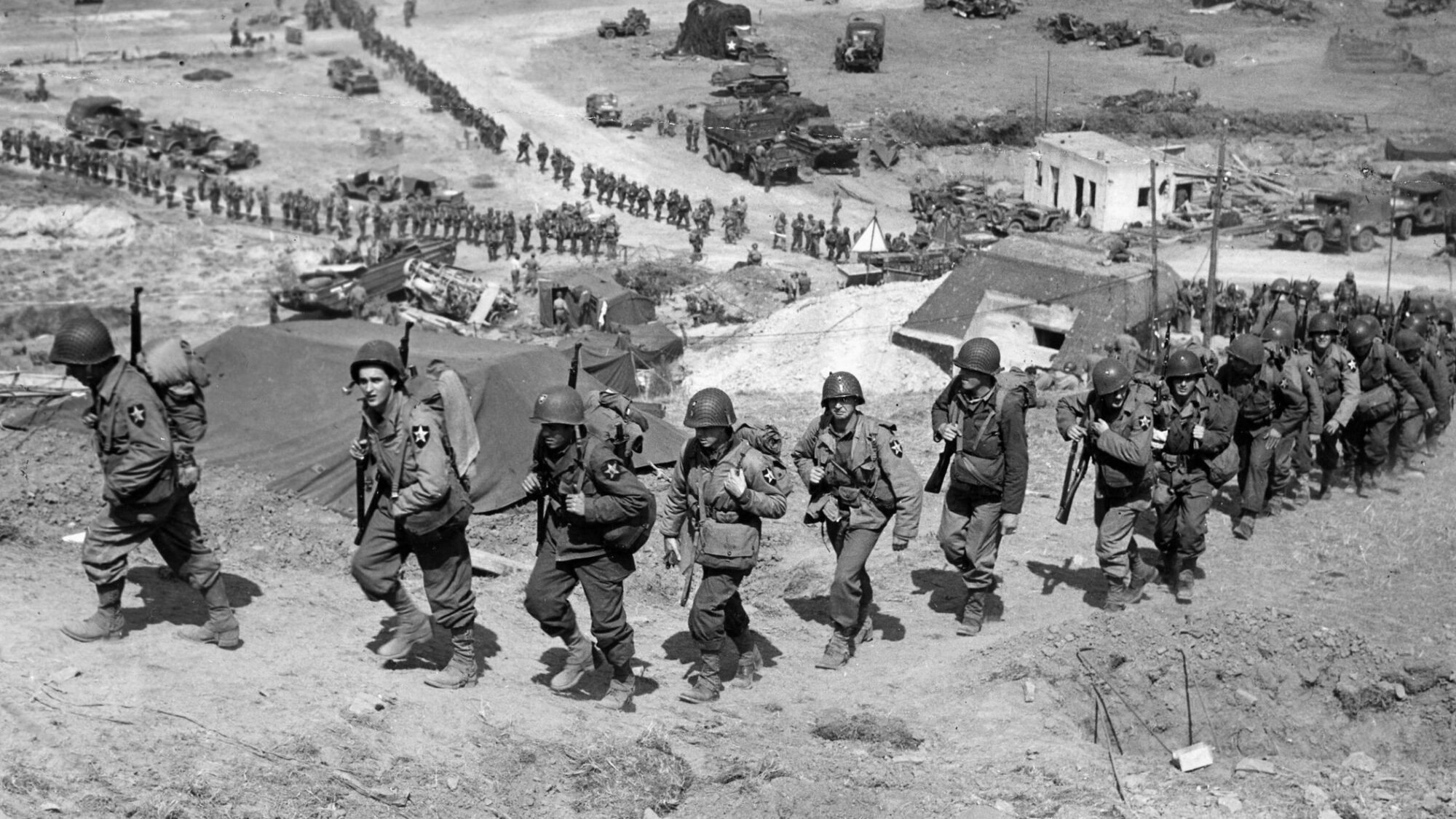The term “GI” is deeply ingrained in American military vernacular, especially associated with the soldiers who fought in World War II. This term has transcended its military origins to become a symbol of a generation of soldiers who played a pivotal role in one of the most significant conflicts in history. This article explores the origins, evolution, and significance of the term “GI” within the context of World War II and its enduring legacy in American culture. Origin of the Term “GI” The term “GI” stands for “Government Issue” or “General Issue.” It was used to describe the items issued to American soldiers, ranging from clothing to gear, indicating that these were standard government-issued supplies. Over time, the soldiers themselves began to be referred to as “GIs,” symbolizing the standardization and uniformity expected of them during their service.
The Early Days
Before the term gained popularity during World War II, its origins can be traced back to World War I. Military supply catalogues and official documentation often stamped equipment and uniforms with “G.I.” to denote that they were property of the government. This label was not initially endearing; soldiers humorously referred to themselves as “G.I. Joe,” a nod to the impersonal nature of their equipment. This sense of humor helped soldiers bond over shared experiences and challenges, setting the stage for the term’s later adoption.
From Equipment to Identity
As the term transitioned from gear to soldiers, it began to represent not just the items they carried but also their collective identity. Soldiers were issued everything from “G.I. soap” to “G.I. socks,” and soon the term began to encapsulate the very essence of being a soldier. This transition was gradual but became solidified during World War II as the sheer scale of the conflict required a unified identity.
Historical Context
The concept of “GI” emerged more prominently during World War II, a period marked by an unprecedented mobilization of American soldiers. The term was used to instill a sense of unity and identity among the troops, many of whom came from diverse backgrounds but were united under a common cause.
Mobilization and Unity
World War II saw the mobilization of over 16 million American men and women, a herculean effort that required a unifying identity. The term “GI” provided this unity, symbolizing the democratization of the armed forces. Soldiers from every walk of life, whether they were from the bustling streets of New York or the rural heartlands of Iowa, became part of the “GI” family, fostering camaraderie and mutual support.
Training and Standardization
The standardization process began in training camps across the United States. Soldiers received identical training, wore the same uniforms, and used the same equipment. This uniformity was essential not only for practical reasons but also for building a cohesive fighting force. Shared experiences in training further solidified the “GI” identity, breaking down barriers of class and geography.
Cultural Significance
The term “GI” transcended its original military connotations to embody the spirit and values of the American soldiers in World War II. It came to represent courage, sacrifice, and the democratic ideals for which they fought. The GIs were seen as the embodiment of American resilience and patriotism, a perception that significantly influenced post-war American identity and culture.
Representation in Literature and Art
Writers and artists of the time captured the essence of the “GI” experience, immortalizing it in various forms. Books like “The Naked and the Dead” by Norman Mailer and “The Thin Red Line” by James Jones offered gritty, realistic portrayals of soldier life, while paintings and photographs from artists like Bill Mauldin depicted the everyday struggles and camaraderie of GIs. These works contributed to the cultural mythos of the GI, creating a lasting impression of bravery and resolve.
Influence on Language
The term “GI” also influenced American vernacular, contributing phrases like “GI Joe,” which became synonymous with the archetypal American soldier. Over time, “GI Joe” evolved into a cultural icon, further cementing the idea of the GI as a symbol of American determination and grit. This influence extended beyond wartime, affecting how soldiers were perceived in peacetime and how their contributions were honored.
Media and Pop Culture
The media played a crucial role in popularizing the term “GI.” Newspapers, films, and propaganda material during and after World War II frequently used the term, further embedding it in the American lexicon. Iconic characters and narratives emerged, celebrating the GIs’ heroism and contributing to their mythologization in American history and culture.
Hollywood’s Role
Hollywood embraced the GI, producing films that highlighted their bravery and struggles. Movies such as “Sands of Iwo Jima” and “The Longest Day” dramatized key battles and the spirit of the American soldier, effectively turning the GI into a heroic figure. These films not only entertained but also educated the public about the challenges and sacrifices faced by soldiers, reinforcing the GI’s status as a cultural icon.
Propaganda and Public Perception
During the war, government propaganda depicted GIs as ordinary Americans performing extraordinary feats, which helped boost morale on the home front. Posters and newsreels portrayed them as valiant and determined, encouraging civilians to support the war effort through bonds and resource conservation. This portrayal helped shape public perception, ensuring that GIs were viewed as heroes deserving of admiration and respect.
Post-War Impact
After World War II, the term “GI” continued to resonate, influencing various aspects of American life. The GI Bill, formally known as the Servicemen’s Readjustment Act of 1944, played a pivotal role in shaping post-war American society by providing veterans with benefits, including educational assistance and home loans, which facilitated their reintegration into civilian life and contributed to the country’s economic prosperity.
The GI Bill: A Lifeline for Veterans
The GI Bill was a transformative piece of legislation that offered returning soldiers unprecedented opportunities. By providing access to higher education and vocational training, it enabled millions of veterans to improve their skills and secure better jobs. This not only aided individual economic mobility but also fueled the post-war economic boom, contributing to the growth of the American middle class.
Housing and Suburbanization
Veterans also benefited from the GI Bill’s housing provisions, which made homeownership accessible to many. Low-interest loans and favorable terms allowed GIs to purchase homes, leading to the development of new suburban communities. This shift significantly altered the American landscape, fostering the growth of suburbs and changing the nation’s demographic and cultural fabric.
Legacy
The legacy of the GIs and the term itself endures, symbolizing not just the individual soldiers but also the collective effort and sacrifice of the United States in a pivotal moment in history. The term “GI” has become synonymous with American soldiers, particularly those who served in World War II, reflecting a unique blend of individual valor and collective identity.
Veterans’ Contributions to Society
Many GIs went on to become influential figures in various fields, leveraging their experiences and skills gained during the war. From politics to business, the impact of these veterans was profound. Former GIs like George H. W. Bush and Bob Dole transitioned into prominent political roles, while others made significant contributions in academia, science, and industry, shaping the future of the nation.
Commemorations and Memorials
The enduring legacy of the GI is also reflected in the numerous memorials and commemorations dedicated to their service. Events like Veterans Day and Memorial Day honor their sacrifices, while monuments such as the National World War II Memorial in Washington, D.C., serve as lasting tributes to their courage and dedication. These commemorations ensure that the contributions of GIs are remembered and respected by future generations.
As a symbol, the term “GI” continues to evoke respect and remembrance for those who served, representing a pivotal chapter in the American narrative and a testament to the enduring spirit of those who donned the uniform and became known as GIs. By delving deeper into the historical context and cultural significance of this term, we gain a richer understanding of its impact on American society and its lasting legacy in shaping both past and present perceptions of military service.




